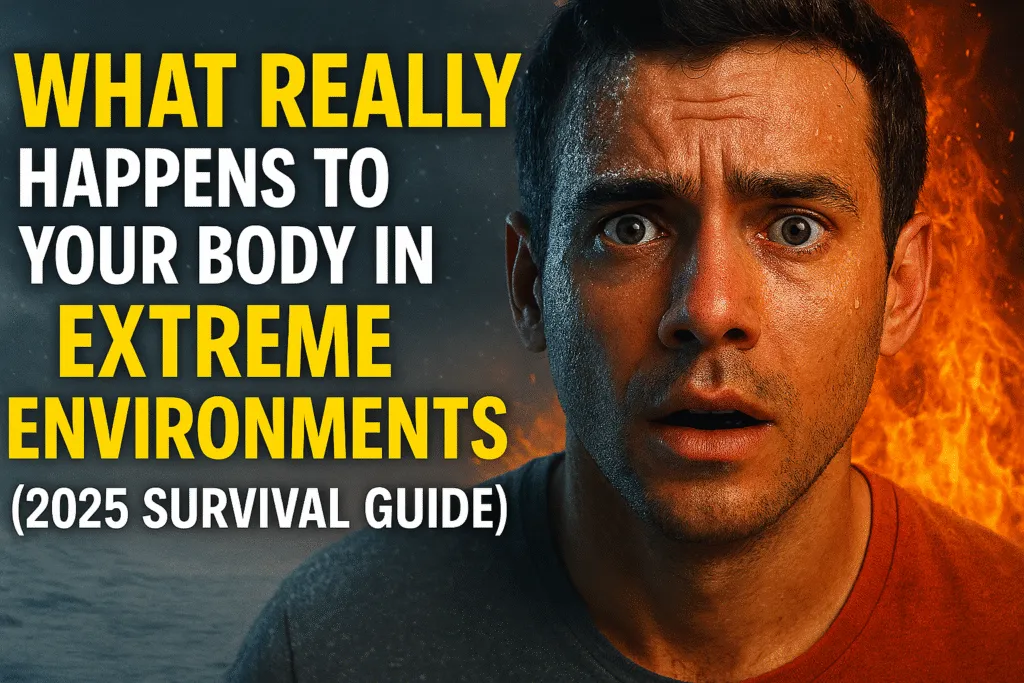Introduction
When we think about adventure, most of us imagine a hike in the mountains, a dive in the ocean, or even a trip to a faraway desert. But few people truly understand what happens to the human body in extreme environments. These are the places and situations where temperatures soar or plummet, oxygen levels drop, or pressure rises to dangerous levels. In such conditions, our bodies are pushed far beyond their comfort zones, forcing them to adapt in ways that can be both fascinating and risky.
The body in extreme environments reacts instantly to protect itself. In intense heat, it works hard to cool down through sweating and increased blood flow to the skin. In freezing cold, it tries to preserve heat by reducing blood flow to the extremities. At high altitudes, the body struggles to get enough oxygen, often leading to shortness of breath and fatigue. Underwater, the pressure can compress the lungs and affect brain function. Even in space, without gravity, muscles and bones weaken over time.
These extreme conditions test not just physical endurance but also mental resilience. The body’s survival mechanisms kick in, guided by millions of years of evolution. However, without proper preparation, these adaptations might not be enough. That’s why understanding how the body responds is crucial for anyone planning to explore beyond ordinary environments.
From the blistering heat of deserts to the crushing depths of the ocean, the story of the body in extreme environments is a testament to human adaptability. By learning more about these changes, we can better protect ourselves, improve performance, and push the boundaries of what’s possible. The science behind these adaptations reveals just how remarkable the human body truly is.
Extreme Heat
The body in extreme environments like intense heat faces one of its toughest challenges — staying cool enough to survive. When temperatures climb, your body immediately activates its cooling system. Sweat glands release moisture onto the skin, and as it evaporates, it helps lower body temperature. Blood vessels near the skin’s surface also widen, allowing more heat to escape. While these mechanisms work well in moderate heat, extreme conditions can overwhelm them.
In severe heat, dehydration becomes a major threat. The more you sweat, the more water and essential salts you lose. Without replenishment, this can lead to heat exhaustion, marked by dizziness, weakness, and nausea. If body temperature rises too high, heatstroke can set in — a dangerous condition that can cause confusion, organ damage, or even death if not treated quickly.
The body in extreme environments also uses behavioral adaptations to cope with heat. You might feel the urge to seek shade, slow down, or drink more water. These instinctive actions are part of your survival response, helping reduce the strain on your heart and cooling system. However, in deserts or other high-temperature areas, shade and water may be hard to find, increasing the risk of overheating.
Even for trained athletes or experienced explorers, extreme heat requires careful planning. Wearing light, breathable clothing, staying hydrated, and avoiding peak sun hours can make a big difference. Understanding how your body reacts under these conditions is key to preventing heat-related illnesses and ensuring safety.
The science of how the body handles extreme heat highlights its remarkable ability to adapt — but it also shows the limits of human endurance. Recognizing those limits can mean the difference between a successful journey and a medical emergency.
Extreme Cold
The body in extreme environments such as freezing temperatures faces the opposite challenge of heat — conserving warmth to protect vital organs. When exposed to intense cold, the body quickly reduces blood flow to the hands, feet, and skin to minimize heat loss. This is why your fingers and toes often feel numb first. At the same time, muscles start shivering involuntarily, generating heat through rapid contractions.
In extremely low temperatures, the risk of hypothermia becomes a serious concern. This condition occurs when your core body temperature drops below the level needed for normal bodily functions. Early signs include intense shivering, confusion, and fatigue. If the cooling continues, shivering may stop, signaling a dangerous drop in body heat. Frostbite is another threat, where skin and underlying tissues freeze, potentially leading to permanent damage.
The body in extreme environments also engages mental and behavioral responses to the cold. You may instinctively huddle, move closer to heat sources, or limit activity to conserve energy. While these reactions help, cold conditions can impair judgment and slow reflexes, making survival decisions more difficult.
Proper preparation is essential when facing extreme cold. Layered clothing, insulated gear, and staying dry are key strategies for maintaining warmth. Even a small amount of moisture from sweat or snow can accelerate heat loss. Consuming warm food and drinks also helps keep energy levels stable and supports internal heat production.
The human body is highly adaptable, but cold pushes those limits fast. Understanding how the body responds to freezing temperatures allows us to better prepare, avoid injury, and survive in some of the harshest conditions on Earth.
High Altitude
The body in extreme environments like high-altitude regions faces a unique challenge — reduced oxygen availability. As you climb higher, the air becomes thinner, meaning there’s less oxygen in each breath. To compensate, your body immediately increases breathing rate and heart rate, working harder to deliver enough oxygen to your muscles and organs. This adjustment happens quickly, but it’s often not enough to prevent symptoms of altitude sickness.
Altitude sickness can range from mild headaches and dizziness to severe conditions like high-altitude pulmonary edema (HAPE) or high-altitude cerebral edema (HACE), both of which can be life-threatening. These occur when low oxygen levels cause dangerous fluid buildup in the lungs or brain. Even experienced climbers are not immune, and the risk increases with rapid ascent.
Over time, the body in extreme environments like high mountains begins to adapt. It produces more red blood cells to carry oxygen more efficiently, and the lungs improve their ability to absorb it. This process, called acclimatization, can take days or even weeks, depending on the altitude. Without it, prolonged exposure can strain the heart and lead to serious health issues.
Survival at high altitude requires careful pacing, proper hydration, and gradual ascent. Many mountaineers follow the “climb high, sleep low” method to help their bodies adjust. Supplemental oxygen is also used in extreme cases, such as climbing above 8,000 meters, where the air is dangerously thin.
While the human body is capable of adapting to high-altitude conditions, those adaptations have limits. Understanding the science behind these changes not only improves safety but also allows adventurers to push further into the world’s highest peaks without compromising their health.
Deep Underwater Pressure
The body in extreme environments such as deep underwater faces intense physical stress from the surrounding water pressure. For every 10 meters you descend, the pressure increases by roughly one atmosphere, squeezing the body far more than most people realize. While human tissue can handle pressure fairly well, air-filled spaces like the lungs, sinuses, and middle ear are affected immediately. Without equalizing, this can cause discomfort, pain, or even injury.
One of the biggest risks in deep dives is nitrogen narcosis, a condition caused by breathing compressed air at depth. The excess nitrogen dissolves into the bloodstream, affecting the brain and leading to confusion, poor judgment, and even euphoria — a dangerous combination underwater. Another serious threat is decompression sickness, or “the bends,” which happens when dissolved gases form bubbles in the body during a rapid ascent. These bubbles can cause joint pain, nerve damage, or even be fatal if they block blood flow.
To cope, the body in extreme environments like the ocean depths relies on proper diving techniques and equipment. Scuba divers equalize pressure in their ears, ascend slowly to avoid gas bubbles, and sometimes use specialized gas mixtures to reduce nitrogen exposure. Professional divers and submariners also undergo rigorous training to understand their limits and manage emergencies.
Interestingly, certain marine mammals have natural adaptations that allow them to dive deep without harm, such as collapsible lungs and the ability to store oxygen in muscles. Humans, however, must rely on technology and training to explore similar depths safely.
Understanding how pressure affects the body is crucial for anyone venturing into deep waters. Respecting these limits ensures that the experience remains an exciting exploration rather than a medical emergency.
Outer Space
The body in extreme environments like outer space faces challenges unlike any on Earth. In the vacuum of space, there is no air, no atmospheric pressure, and constant exposure to radiation from the sun and cosmic rays. Without a spacesuit, the lack of pressure would cause body fluids to boil at normal body temperature, and unconsciousness would occur within seconds due to the absence of oxygen.
Even in a controlled spacecraft, zero gravity has profound effects on the human body. Without the pull of gravity, muscles no longer need to work as hard, and bones lose density over time, a condition similar to osteoporosis. Astronauts can experience muscle weakening, reduced cardiovascular efficiency, and a higher risk of fractures if they stay in space for long periods. The body in extreme environments like space must also adapt to shifts in bodily fluids — without gravity, fluids move upward, causing facial puffiness and increased pressure inside the head, which can affect vision.
Radiation is another constant threat. Unlike Earth’s protective atmosphere, space offers little shielding from harmful rays. Prolonged exposure can increase the risk of cancer, damage cells, and even affect the central nervous system. This is why spacecraft and spacesuits are designed with protective layers to reduce exposure.
Astronauts counteract these challenges through daily exercise, careful nutrition, and medical monitoring. Resistance training, cycling, and treadmill workouts help maintain muscle and bone strength. When they return to Earth, re-adapting to gravity can be difficult, requiring weeks or months of rehabilitation.
Exploring space pushes the limits of human endurance and technology. Understanding how the body in extreme environments like space responds is key to preparing for longer missions — including the possibility of traveling to Mars or beyond.
Deserts vs. Rainforests
The body in extreme environments like deserts and rainforests faces two very different survival challenges, both tied to climate and water balance. In deserts, the main threat is dehydration due to intense heat and extremely low humidity. Sweat evaporates quickly, making it harder to notice just how much fluid you’re losing. Without enough water, blood volume drops, circulation slows, and heat-related illnesses such as heat exhaustion or heatstroke can set in. The body conserves water by producing less urine and reducing sweat output, but this is only a short-term defense.
In contrast, rainforests present the opposite problem — excessive humidity and constant moisture. High humidity slows down sweat evaporation, making it harder for the body to cool itself efficiently. This can lead to overheating even without extreme air temperatures. The damp conditions also increase the risk of skin infections, fungal growth, and insect-borne diseases. Constant rainfall can cause clothing and gear to stay wet, draining body heat and increasing fatigue over time.
The body in extreme environments like these adapts through both physical and behavioral changes. In deserts, lighter clothing, seeking shade, and moving during cooler hours help protect against heat. In rainforests, wearing breathable yet protective clothing, staying dry, and avoiding prolonged exposure to standing water reduce health risks. Both environments require careful hydration strategies — in deserts to replace lost fluids, and in rainforests to ensure water sources are safe to drink.
Surviving in deserts and rainforests demands respect for the climate’s unique challenges. Whether battling dry heat or humid heat, the key is understanding how your body reacts and making smart adjustments to maintain balance and safety.
Surviving Natural Disasters
The body in extreme environments during natural disasters is pushed into survival mode within seconds. Earthquakes, floods, hurricanes, or wildfires trigger the body’s fight-or-flight response, releasing adrenaline and stress hormones to prepare for immediate action. Heart rate and breathing speed up, muscles tighten, and the senses sharpen, all designed to help you react quickly and improve your chances of survival.
In situations like these, the body also prioritizes essential functions. Blood flow shifts toward major muscles and away from non-essential processes like digestion. This burst of energy is helpful for escaping danger, but it also burns through your reserves quickly. Extended exposure to extreme stress can lead to fatigue, dehydration, and mental exhaustion.
The body in extreme environments like disaster zones must also cope with unpredictable hazards. In floods, cold water can cause hypothermia within minutes. In wildfires, smoke inhalation can damage the lungs and reduce oxygen intake. During earthquakes or building collapses, injuries combined with shock can make survival even more challenging.
Survival often depends on quick decision-making and preparedness. Having an emergency plan, knowing escape routes, and keeping essential supplies like water, food, and first aid kits ready can significantly improve your safety. After the immediate danger passes, the body may still suffer from stress-related effects such as anxiety, insomnia, or weakened immunity.
Natural disasters test both physical and mental resilience. By understanding how the body responds in these high-pressure situations, you can train yourself to stay calm, act efficiently, and recover more effectively once the crisis is over.
Psychological Impact of Extreme Environments
The body in extreme environments is not only tested physically but also mentally. Harsh conditions such as isolation in polar regions, darkness during long winters, or confinement in space stations can place intense stress on the mind. In these settings, the brain works harder to process danger, uncertainty, and discomfort, often leading to increased production of stress hormones like cortisol.
Over time, constant exposure to extreme environments can cause fatigue, anxiety, and difficulty concentrating. In survival situations, mental clarity is just as important as physical endurance, because decision-making under pressure can determine life or death. For example, a stranded climber in a snowstorm or a diver lost underwater must think clearly despite fear and exhaustion.
Isolation is one of the biggest psychological challenges. The lack of social contact can lead to feelings of loneliness, depression, or irritability. This is why astronauts, explorers, and researchers in remote stations are often trained in teamwork, communication, and stress management before facing these conditions. The body in extreme environments responds to emotional stress much like it does to physical danger — heart rate increases, breathing quickens, and muscles tense in preparation for action.
Coping strategies play a key role in maintaining mental health in extreme conditions. Staying mentally active, following routines, and practicing relaxation techniques can help reduce stress. Support systems, whether through teammates or communication with loved ones, also make a significant difference in mental resilience.
Understanding the psychological impact is vital because even a strong, well-prepared body can fail if the mind becomes overwhelmed. Extreme environments challenge the whole human system, and protecting mental health is just as essential as safeguarding physical survival.
Conclusion
The body in extreme environments is a remarkable example of human adaptability and survival. From the scorching heat of deserts to the crushing depths of the ocean, from oxygen-starved mountain peaks to the vacuum of space, the human body constantly works to maintain balance and protect itself. These survival mechanisms — whether physical, like regulating temperature and oxygen intake, or mental, like staying focused under stress — are the result of millions of years of evolution.
However, every adaptation has its limits. Without proper preparation, knowledge, and the right tools, even the strongest body can fail in extreme environments. That’s why understanding how the body reacts in these situations is not just interesting science, but a crucial part of safety for adventurers, explorers, and anyone who may face harsh conditions.
The body in extreme environments teaches us the importance of respecting nature’s power. Extreme heat, cold, pressure, or isolation are not just obstacles to overcome — they are forces that demand careful planning and respect. With training, experience, and awareness, we can extend those limits and explore further than ever before, while minimizing the risks.
In the end, studying these responses doesn’t just help us survive; it helps us thrive. By learning how the human body adapts to extremes, we gain a deeper appreciation of its resilience, pushing us to prepare better, travel smarter, and face challenges with confidence.
Also Read: The Most Mysterious Elements on the Periodic Table – 2025’s Strangest Atomic Secrets.
FAQs
1. How does the body in extreme environments adapt to heat and cold?
In heat, the body cools itself through sweating and increased blood flow to the skin. In cold, it conserves heat by reducing blood flow to extremities and producing warmth through shivering.
2. What are the biggest dangers at high altitude?
The main risks include altitude sickness, low oxygen levels, and fluid buildup in the lungs or brain. Proper acclimatization helps the body in extreme environments cope with these challenges.
3. Can humans survive deep underwater without special equipment?
No. The intense water pressure can crush air-filled spaces in the body, and without breathing equipment, oxygen runs out in minutes. Divers use gear and techniques to handle these conditions safely.
4. How does space affect the human body?
In zero gravity, muscles weaken, bones lose density, and bodily fluids shift upward, affecting vision and circulation. Radiation exposure is also a major concern for the body in extreme environments like space.
5. Why is mental health important in extreme environments?
Harsh conditions can cause stress, anxiety, and poor decision-making. Maintaining mental resilience is as vital as physical strength for survival.
6. What is the key to surviving natural disasters?
Quick decision-making, an emergency plan, and basic survival supplies can greatly improve safety in sudden, life-threatening situations.





























